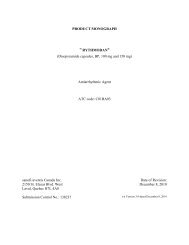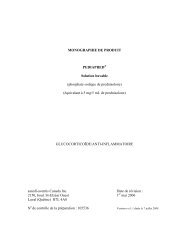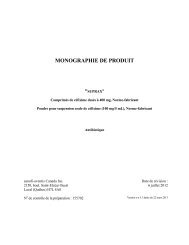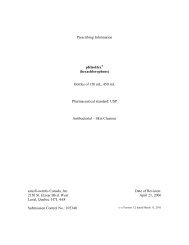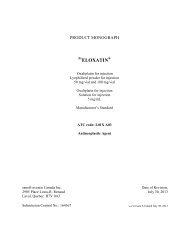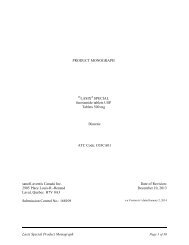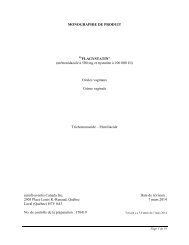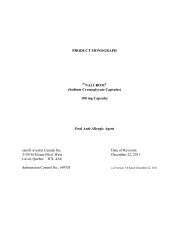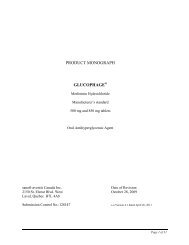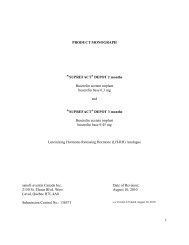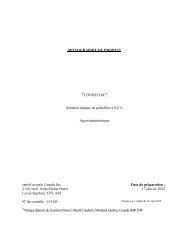Trental (pentoxifylline) - Sanofi Canada
Trental (pentoxifylline) - Sanofi Canada
Trental (pentoxifylline) - Sanofi Canada
Create successful ePaper yourself
Turn your PDF publications into a flip-book with our unique Google optimized e-Paper software.
PRODUCT MONOGRAPHPrTRENTAL ®(<strong>pentoxifylline</strong> sustained release tablets, 400 mg Mfr. Std.)Vasoactive agentATC Code : C04AD03sanofi-aventis <strong>Canada</strong> Inc.Date of Revision:2150 St. Elzear Blvd. West March 30, 2011Laval, Quebec H7L 4A8Submission Control No.: 142355 s-a 4.0 Version dated March 30, 2011Page 1 of 21
Table of ContentsPART I: HEALTH PROFESSIONAL INFORMATION................................. 3SUMMARY PRODUCT INFORMATION........................................................ 3INDICATIONS AND CLINICAL USE ............................................................. 3CONTRAINDICATIONS .................................................................................. 3WARNINGS AND PRECAUTIONS ................................................................. 4ADVERSE REACTIONS................................................................................... 5DRUG INTERACTIONS ................................................................................... 7DOSAGE AND ADMINISTRATION ............................................................... 8OVERDOSAGE ................................................................................................. 8ACTION AND CLINICAL PHARMACOLOGY.............................................. 9STORAGE AND STABILITY ........................................................................... 9DOSAGE FORMS, COMPOSITION AND PACKAGING ............................. 10PART II: SCIENTIFIC INFORMATION ....................................................... 11PHARMACEUTICAL INFORMATION......................................................... 11DETAILED PHARMACOLOGY .................................................................... 12TOXICOLOGY ................................................................................................ 14REFERENCES ................................................................................................. 18PART III: CONSUMER INFORMATION...................................................... 20Page 2 of 21
WARNINGS AND PRECAUTIONSGeneralAt the first signs of an anaphylactic/anaphylactoid reaction, <strong>Trental</strong> must be discontinued and aphysician must be informed.Patients with hepatic impairment should be closely monitored during <strong>Trental</strong> therapy and mayrequire lower doses. Since <strong>Trental</strong> (<strong>pentoxifylline</strong>) is extensively metabolized in the liver, the useof this drug is not recommended in patients with severe hepatic impairment of liver function(Child-Pugh class C, score > 9).Patients with renal impairment (creatinine clearance below 80 mL/min) should be closelymonitored during <strong>Trental</strong> therapy and may require lower doses. Since <strong>Trental</strong> (<strong>pentoxifylline</strong>) iseliminated through the kidneys, the use of this drug is not recommended in patients with severerenal impairment (creatinine clearance below 30 mL/min).CardiovascularLow, labile blood pressure: Caution should be exercised when administering <strong>Trental</strong>(<strong>pentoxifylline</strong>) to patients with low or labile blood pressure. In such patients any dose increaseshould be done gradually and careful monitoring is required.Patients with severe cardiac arrhythmias should be closely monitored during <strong>Trental</strong> therapy.HematologicThe administration of <strong>Trental</strong> has been associated with bleeding and/or prolonged prothrombintime (see DRUG INTERACTIONS). The risk of bleeding may be increased by combinedtreatment with anticoagulant agents or use in coagulation disorders. Therefore, in patients withcoagulation disorders or being treated with anticoagulant therapy, <strong>Trental</strong> should be used withcaution and only, when in the physician’s judgement, the potential benefit outweighs the risk.Careful monitoring is required.Page 4 of 21
Special PopulationsPregnant WomenReproduction studies have been performed in rats, mice and rabbits at doses up 23, 2 and 11times the maximum recommended daily human dose and have revealed no evidence of impairedfertility or harm to the fetus due to <strong>pentoxifylline</strong>. The drug has been shown to cross the bloodplacentabarrier in mice. There is no adequate experience in pregnant women. Therefore, <strong>Trental</strong>is not recommended for women who are, or may become, pregnant unless the expected benefitsfor the mothers outweigh the potential risk to the fetus.Nursing WomenPentoxifylline and its major metabolites are excreted in human milk, following a 400 mg singleoral dose of <strong>Trental</strong>. The patient should be advised to discontinue nursing or to discontinuetaking the drug depending on the importance of the drug to the mother.PediatricsThe use of <strong>Trental</strong> in patients below the age of 18 years is not recommended as safety andeffectiveness have not been established in this age group.Geriatrics<strong>Trental</strong> should be used with caution in elderly patients as peak plasma levels of <strong>pentoxifylline</strong>and its metabolites are moderately higher in this age group. Elderly patients had a slight increasein the incidence of some adverse effects. Careful dose adjustment is therefore recommended.ADVERSE REACTIONSClinical Trial Adverse Drug ReactionsBecause clinical trials are conducted under very specific conditions the adverse reaction ratesobserved in the clinical trials may not reflect the rates observed in practice and should not becompared to the rates in the clinical trials of another drug. Adverse drug reaction informationfrom clinical trials is useful for identifying drug-related adverse events and for approximatingrates.The most frequent adverse event reported with <strong>Trental</strong> (<strong>pentoxifylline</strong>) is nausea (14%).Individual signs/symptoms listed in the table below occurred at an incidence between 1 and 3%,except when stated otherwise.Page 5 of 21
SymptomsBody as a wholeMalaiseCardiovascular system FlushingCentral nervous system Dizziness/light-headedness (9.4%),headache (4.9 %)Gastrointestinal system Nausea (14%), vomiting (3.4%),abdominal discomfort, bloating,diarrhea, dyspepsiaLess Common Clinical Trial Adverse Drug Reactions (
Skin and subcutaneous tissue disorders: Reddening of skin.Vascular disorder: HaemorrhageDRUG INTERACTIONSDrug-Drug InteractionsAntacids: In patients with digestive side effects, antacids may be administered with <strong>Trental</strong>. Incomparative bioavailability study, no interference with absorption of <strong>Trental</strong> by antacids wasobserved.Antihypertensive agents: <strong>Trental</strong> (<strong>pentoxifylline</strong>) may potentiate the action of antihypertensiveagents. Patients receiving these agents require blood pressure monitoring and possibly a dosereduction of the antihypertensive agents.Anticoagulants: There have been reports of bleeding and/or prolonged prothrombin time inpatients treated with <strong>Trental</strong> with and without anticoagulants, including vitamin K antagonists, orplatelet aggregation inhibitors. Monitoring of anti-coagulant activity in these patients isrecommended when <strong>pentoxifylline</strong> is introduced or the dose is changed.Patients on warfarin should have more frequent monitoring of prothrombin time, while patientswith other risk factors complicated by hemorrhage (e.g. recent surgery) should have periodicexaminations for signs of bleeding, including hematocrit and haemoglobin.Cimetidine: During concurrent use of cimetidine and <strong>pentoxifylline</strong>, cimetidine has been shownto significantly increase the steady-state plasma concentration of <strong>pentoxifylline</strong>, which mayenhance the possibility of adverse effects.Erythromycin: No data are available on the possible interaction of <strong>Trental</strong> and erythromycin.However concurrent administration of erythromycin and theomycin has resulted in significantelevation of serum theophylline levels with toxic reactions.Hypoglycemic agents: The blood-sugar lowering effect of insulin or oral antidiabetic agentsmay be potentiated. In patients treated with hypoglycemic agents, a moderate adjustment in thedose of these agents may be required when <strong>Trental</strong> is prescribed. Therefore it is recommendedthat patients under medication for diabetes mellitus be carefully monitoredSympathomimetics: Combined use with other xanthines or with sympathomimetics may causeexcessive CNS stimulation.Theophylline: Although causality has not been established, concurrent use of <strong>pentoxifylline</strong>with theophylline has resulted in elevated theophylline plasma levels, which may enhance thepossibility of adverse effects.Page 7 of 21
Drug-Food InteractionsInteractions with food have not been established.Drug-Herb InteractionsInteractions with herbal product have not been established.Drug-Laboratory InteractionsInteractions with laboratory tests have not been established.Drug-Lifestyle InteractionsInteractions with lifestyles have not been established.DOSAGE AND ADMINISTRATIONRecommended Dose and Dosage AdjustmentThe recommended starting dosage of <strong>Trental</strong> (<strong>pentoxifylline</strong>) is 400 mg twice daily after meals.The usual dose is 400 mg twice or three times daily. A maximum of 400 mg three times dailyshould not be exceeded.It may take up to two months to obtain full results.<strong>Trental</strong> 400 mg sustained release tablets must be swallowed whole.OVERDOSAGEOverdosage with <strong>Trental</strong> (<strong>pentoxifylline</strong>) has been reported in children and adults. Symptomsappear to be dose related and usually occurred 4-5 hours after ingestion and lasted about 12hours. Initial manifestations of acute overdose with <strong>pentoxifylline</strong> may be nausea, dizziness,tachycardia, fever, gastrointestinal bleeding – coffee-ground vomiting and areflexia. The highestamount ingested was 80 mg/kg with which flushing, hypotension, convulsions, somnolence, lossof consciousness, fever, and agitation have been observed. All patients recovered.No specific antidote is known. In addition to symptomatic treatment and gastric lavage, specialattention must be given to supporting respiration, maintaining systemic blood pressure, andcontrolling convulsions with intravenous diazepam. Activated charcoal has been used to absorb<strong>pentoxifylline</strong> in patients who have overdosed.For management of a suspected drug overdose, contact your regional Poison Control Centre.Page 8 of 21
ACTION AND CLINICAL PHARMACOLOGYMechanism of Action<strong>Trental</strong> (<strong>pentoxifylline</strong>) is a xanthine derivative. It belongs to a group of vasoactive drugs whichimprove peripheral blood flow and thus enhance peripheral tissue oxygenation. The mechanismby which <strong>Trental</strong> achieves this effect has not been determined, but it is likely that the followingfactors are involved:• <strong>Trental</strong>, as with other xanthine derivatives, relaxes certain smooth muscles includingthose of the peripheral vessels, thus causing vasodilatation or preventing spasm. Thisaction, however, may have a limited role in patients with chronic obstructive arterialdisease when peripheral vessels are already maximally dilated.• <strong>Trental</strong> improves flexibility of red blood cells. This increase in the flexibility of red bloodcells probably contributes to the improvement of the ability of blood to flow throughperipheral vessels (haemorheologic action). This property was seen during in vitro and invivo experiments with <strong>Trental</strong> but the correlation between it and the clinical improvementof patients with peripheral vascular diseases has not been determined.• <strong>Trental</strong> promotes platelet deaggregation.Improvement of red blood cell flexibility and platelet deaggregation contribute to the decrease inblood viscosity.PharmacokineticsPentoxifylline is almost completely absorbed after oral administration. The <strong>Trental</strong> 400 mgsustained release tablet showed an initial peak plasma <strong>pentoxifylline</strong> concentration 2 to 3 hourspost-administration. The drug is extensively metabolized. The active main metabolite 1-(5-hydroxyhexyl)-3,7-dimethyl-xanthine (metabolite I) is measurable in twice the concentration inplasma of that of its parent substance. Biotransformation products are almost exclusivelyeliminated by the kidneys.Food intake before the administration of <strong>Trental</strong> delayed the absorption but did not decrease it.STORAGE AND STABILITYStore at room temperature (15 to 30 °C). Protect from light.Protect from moisture and excessive heat.Page 9 of 21
DOSAGE FORMS, COMPOSITION AND PACKAGINGComposition<strong>Trental</strong> sustained release tablets 400 mg contain 400 mg medicinal ingredient, <strong>pentoxifylline</strong>.The qualitative formulation of <strong>Trental</strong> tablets is: <strong>pentoxifylline</strong>, benzyl alcohol, FD&C red no.3,hydroxyethyl cellulose, hydroxypropyl methylcellulose, magnesium stearate, polyethylene glycol8000, povidone, talc, titanium dioxide.Availability<strong>Trental</strong> (<strong>pentoxifylline</strong>) is available as 400 mg, pink, oblong, film-coated, sustained releasetablets, packed in Unit Pack boxes of 60 [4x15 clear PVC film and aluminium foil blisterpacked]tablets. One face is debossed with "<strong>Trental</strong>", the other face is plain.Page 10 of 21
PART II: SCIENTIFIC INFORMATIONPHARMACEUTICAL INFORMATIONDrug SubstanceProper name:Chemical name:<strong>pentoxifylline</strong>3,7-Dihydro-3,7-dimethyl-1-(5-oxohexyl)-1H-purine-2,6-dioneMolecular formula: C 13 H 18 N 4 O 3Molecular mass: 278.3Structural formula:Description:Pentoxifylline is a white to creamy white, crystalline powder. It isfreely soluble in chloroform and methanol, soluble in water,sparingly soluble in ethanol and slightly soluble in ether. It has amelting point of 104°C to 107°C, within a 3°C range.Page 11 of 21
DETAILED PHARMACOLOGYIn vitro and in vivo Animal DataPharmacodynamicsIn dogs, 10mg/kg/i.v <strong>pentoxifylline</strong> produced a short but significant drop in BP. 5-15 mg/kg/i.v.<strong>pentoxifylline</strong> produced a dose related increase in heart rate and decrease in peripheral resistancefor 30-60 minutes. In dogs, cats, and rats, after 1-3 mg/kg <strong>pentoxifylline</strong> i.v. the blood pressure,heart rate and respiration remained practically unchanged whereas higher doses of <strong>pentoxifylline</strong>(14-25 mg/kg/i.v.) caused a transient decrease in blood pressure and an increase in heart rate. Inrabbits <strong>pentoxifylline</strong> (2-10 mg/kg/i.v.) produced a dose related fall in BP. In rabbits, cats anddogs the respiration was slightly stimulated. The blood pressure response in cats and rabbits afterepinephrine was slightly inhibited by <strong>pentoxifylline</strong>. The i.v. administration of <strong>pentoxifylline</strong> oraminophylline in doses of 3-10 mg/kg to cats resulted in a 20 and 35 % increase on dp/dtrespectively.Femoral musculature circulation in cat, measured indirectly by heat-conduction probe, wasincreased by <strong>pentoxifylline</strong> (10-50 mg/kg/p.o. and 1-20 mg/kg/i.v.) and papaverine (1 mg/kg/i.v)while aminophylline (1-10 mg/kg/i.v) was without effect. In hepatic circulation in cat,<strong>pentoxifylline</strong> (2 mg/kg/i.v) was as effective as papaverine (1 mg/kg/i.v.) in increasing bloodflow.In carotid artery blood of anaesthetized cat, <strong>pentoxifylline</strong> (5 mg/kg/i.v.) produced a 5.8 mmHgincrease in PO 2 whereas papaverine, (1 mg/kg/i.v) produced a 4.0 mmHg increase,aminophylline 3 mg/kg/i.v. produced a 1 mmHg increase in PO 2 and 5 mg/kg/i.v. reduce O 2tension 1mmHg.Reserpine pre-treatment did not influence the positive chronotropic effect of <strong>pentoxifylline</strong> inrats.On isolated rabbit hind limb, <strong>pentoxifylline</strong>-induced vasodilatation was comparable toacetylcholine-induced vasodilatation at equal doses.In isolated guinea pig heart preparation, <strong>pentoxifylline</strong> (30-600 μg) produced no significanteffect on contractility or heart rate and small increase in coronary flow while aminophylline (30-808 μg) produced a biphasic effect on coronary flow, slight negative inotropism and no ratealteration. The activity of <strong>pentoxifylline</strong> on coronary flow was not influenced by propanolol (7.5μg). In isolated guinea pig tracheal chain, the bronchodilator activity of <strong>pentoxifylline</strong>, wassignificantly greater than aminophylline. The presence of propanolol 10 -6 g/mL did not affectresults.Contractions induced in isolated guinea pig seminal vesicle by epinephrine were reduced by<strong>pentoxifylline</strong> and by aminophylline in the same concentration range.Page 12 of 21
Bronchospasm induced by i.v. acetylcholine in guinea pigs was inhibited by 97%, and thatinduced by i.v. histamine inhibited by 100%, at <strong>pentoxifylline</strong> doses of 50 mg/kg/i.v. and 20mg/kg/i.v. respectively.On rabbit aorta strip preparation both <strong>pentoxifylline</strong> and aminophylline inhibited the NE-inducedcontraction.The histamine-induced increase of capillary permeability in rats was not influenced by 10 or 25mg/kg <strong>pentoxifylline</strong> i.p.Pentoxifylline given orally (25-100 mg/kg) to rats had no influence on blood sugar while inrabbits given i.v. (10-50 mg/kg) the higher dose <strong>pentoxifylline</strong> increased blood sugar from 100 to187 mg% at 1 hour post-dosing.In comparison to aminophylline, the central stimulatory effect of <strong>pentoxifylline</strong> in rats wassignificantly milder. Pentoxifylline (40 and 200 mg/kg/p.o.) did not prevent convulsions inducedby nicotine in mice. Pentoxifylline does not influence significantly the motility of mice and rats,food consumption of rats, sleeping time after hexobarbital in rats and mice, ptosis, sedation andhypothermia of mice caused by reserpine, catalepsy in rats induced by perphenazine of fightingbehaviour in mice. It has no anticonvulsive, anti-inflammatory and local anaesthetic activity andexhibits only a slight analgesic, cholorectic, diuretic and antitussive effect.The results of in vitro studies in which <strong>pentoxifylline</strong> was added to blood from humanvolunteers, and in vivo studies in which <strong>pentoxifylline</strong> was given orally or intravenously topatients with peripheral vascular disease indicate that <strong>pentoxifylline</strong> can improve impairederythrocyte flexibility. The possible mechanism involved in this effect are most likely related tointracellular adenosine triphosphate (ATP) inasmuch as ATP depleted cells have reducedflexibility and vice versa. Pentoxifylline raises erythrocytes intracellular ATP concentrations. Inanother in vitro study using rat erythrocytes, <strong>pentoxifylline</strong> has been shown to decreaseintracellular Ca ++ concentrations and increase phosphorylation of the proteins in the erythrocytesmembrane by facilitating Mg ++ dependent phosphoprotein phosphatase and transglutaminaseactivity. This results in an increased membrane phosphoprotein concentration, which is believedto increase red blood cell flexibility.In an in vivo rat study designed to test platelet deaggregation properties of drugs, <strong>pentoxifylline</strong>at doses of 3,6 and 12 mg/kg/i.v. reduced platelet aggregation to “sticky” cancer cells (Walker256 carcinosarcoma) and inhibited their attachment to endothelium. Monkeys given<strong>pentoxifylline</strong> 6, 12, 18 and 24 mg/kg/i.v. exhibited dose related reduction in platelet aggregationindex. In human <strong>pentoxifylline</strong> inhibits ADP-stimulated platelet aggregation as measured by theBorn method.Epinephrine-induced lipolysis (rat epididymal adipose tissue) was increased by <strong>pentoxifylline</strong>and aminophylline at 10 -3 and 10 -4 M in vitro. In vivo, epinephrine-induced glycerine production(same tissue) was significantly inhibited by both compounds (10 mg/kg/i.v.) and FFA wasPage 13 of 21
decreased.PharmacokineticsBeagle dogs were given 3.0 mg/kg/p.o <strong>pentoxifylline</strong>- 14 C and radioactivity measured in plasmaand body tissues. Mean maximal blood levels (2.1 μg/mL) were reached 1 hour post-dosing.Plasma concentration/time curve displayed a biphasic elimination profile with t 1/2 0.8 hours and30 hours. Over 80% of the radioactivity was found in urine within 24 hours. At maximal bloodlevels time, highest concentration was found in gallbladder (110.0 μg/g), kidney, liver andbladder (4.8 μg/g): lowest concentrations were found in brain (0.40 μg/g), fat, heart and gonads(1.3 μg/g).TOXICOLOGYAcute ToxicityACUTE TOXICITY (LD 50 ) OF PENTOXIFYLLINESPECIES ROUTE LD 50 (MG/KG)Mousep.oi.v.i.p1385197239Rat (SD)p.oi.v.1772231Toxicity was characterized by hypersalivation in orally dosed animals, increased or irregularrespiration, tonic-clonic convulsions and paresis.Rabbits survived 50 mg i.v; signs and symptoms of toxicity were similar to those seen in rats.Dogs survived 160 mg i.v and 320 mg p.o. They showed aggression and ataxia after oral dosingand aggression, fear, vomiting, diarrhea after i.v dosing.Subacute and Chronic ToxicityMouse i.v., 14 days:Groups of 8 female 12 week old mice were given daily doses of 0, 12.5, 25, 50 or 100 mg/kg of<strong>pentoxifylline</strong>. One mouse of the highest dosage group died after 6 days. Death was preceded bydyspnea and clonic convulsions. The other animals of this group showed a decrease inspontaneous activity and had their eyes closed.Page 14 of 21
Mouse, p.o., 78 weeks:Four groups of 20 males and females were given <strong>pentoxifylline</strong> in diet at 0, 50, 150 or 450mg/kg/day. Five animals per sex per group were killed after 26 weeks and another 5 at 52 weeks.After 78 weeks the remaining animals were observed for 13 weeks, without exposure to thecompound. High dose males showed a greater frequency of bronchiectasis, renal cysts, testicularatrophy, urinary bladder dilatation and bone marrow hyperplasia than controls. High dosefemales showed a greater frequency of bronchiectasis, fatty degeneration of the liver, fattydegeneration/amyloidosis in the kidneys, splenic hyperplasia, hyperplasia and fibrosis of bonemarrow and osteoporosis than controls.There was an increased incidence of benign ovarian and uterine tumours, and angiosarcoma ofthe liver was observed in 1 animal of each sex in the high dose group.Rat, i.v., 14 days:Groups of 10 females were given <strong>pentoxifylline</strong> at daily doses of 0, 12.5, 25, 50 or 100 mg/kg.Four of the 10 rats given 100 mg/kg showed depressed spontaneous activity, staggering gait,closed eyelids, salivation and clonic and tonic convulsions and died. There were pulmonaryhemorrhages in these 4 rats.Rat, i.v, 30 days:Groups of 10 males and 10 females were given <strong>pentoxifylline</strong> in doses of 0, 10, 25 or 50mg/kg/day. There was a slight decrease in cholesterol and esterified cholesterol in the 25 and 50mg/kg male groups and a slight increase in the mean blood glucose level in the 25 and 50 mg/kgfemale groups. Perilobular hyaline droplet degeneration of the liver occurred in all groups, butappeared to be more severe in the male rats of the two highest dosage groups. Females on the topdose displayed increased incidence of renal tubule calcification.Rat, p.o., 78 weeks:Groups of 70 males and 70 females were given <strong>pentoxifylline</strong> in their diet 0, 50, 150 or 450mg/kg/day. Five animals per sex per group were killed at 52 weeks and another 5 at 78 weeks.After 78 weeks the remaining animals were observed for 26 weeks without additional exposureto <strong>pentoxifylline</strong>. In the middle-dose group the body weight gain was significantly decreased; atthe end of the 6 months follow-up period the body weight were normal. In the high-dosage groupthe body weight gain was decreased. At the end of the 6 months follow-up period the femaleweight had returned to normal but the males had not. The mortality rate was significantlyincreased for the males in the high-dose group. The cause of death was similar in treated anduntreated animals, but in the treated animals there was an increase in congestive streaks of theliver, cadiosclerosis and scars in the heart, dilatation of the uterus, and thyroid atrophy (femalesonly). There were more interstitial cell tumours of the testicles in the high dosage group but thedifference was not significant. There was a significant increase in fibroadenomas of themammary gland (females) in the high dose group.Page 15 of 21
Dog, i.v., 30 days:Groups of 3 male and 3 female Beagles were given <strong>pentoxifylline</strong> in doses of 0, 10, 25 and 63mg/kg 5days/week for 6 weeks. There was licking of the lips, vomiting, incoordination,uneasiness and dose-related heart rate increase following the injection. Some tubular renaldegeneration occurred at 25 and 63 mg/kg. There was also congestion of liver at these doses andcongestion of spleen at the highest dose.Dog, p.o., 1 year:Groups of 3 male and 3 female Beagles were given <strong>pentoxifylline</strong> in doses of 0, 32, 100, 320 or400 mg/kg/day. There was incoordination, salivation and altered temperament following drugadministration. Deaths occurred at doses of 320 and 400 mg/kg due to extensive or focalpulmonary oedema and hemorrhages, and marked congestion in mucosa of the intestinal tract.Acetone was detected in urine at 2 weeks to 26 weeks in some dogs of the 3 highest dose groups.At 52 weeks acetone was no longer detected. Giant cell formation in the testicles was observedin 2 dogs, which died in the 320 mg/kg group. Granuloma in the lymph nodes occurred in 1 dogin the control group, and 2 in the 320 mg/kg group.Reproduction and TeratologyMouse, i.v.:Mice were given 0, 12.5, 25 or 50 mg/kg <strong>pentoxifylline</strong> from day 15 of gestation through day 21of lactation. Between days 21 and 23 all the animals were killed. Some of the F 1 offspring werereared and mated. The females and F 2 offspring were raised to weaning, and then killed. Allother F 1 offspring were killed at 10 weeks. There was no significant effect on pregnancy and onthe fetal development.Rat, p.o.:Groups of 10 males and 20 females were given 0, 57, 170 or 570 mg/kg/day <strong>pentoxifylline</strong> for 10weeks before mating and then continuously through gestation and lactation. Fifty percent of thefemales were killed on the 13 th day of gestation and the remaining animals were allowed to raisetheir young to weaning.The number of resorptions, particularly early resorption, was greater in the high dose group. Thenumber of young reared to weaning was lower for the high dose group.Rat, p.o. and i.v.:Groups of 20 females were given <strong>pentoxifylline</strong> 0, 57, 100 or 570 mg/kg orally or 0.8, 3.2 or12.5 mg/kg i.v. from the 6 th or 7 th day to the 16 th day of gestation. Two control groups were usedin the i.v. study. One group was given a volume of physiological NaCl similar to the treatmentPage 16 of 21
groups and the other group was not treated at all. On the 20 th day of pregnancy the fetuses wereremoved by Caesarean section. There was a significant reduction in the number of fetuses in thehighest oral dosage group and the number of resorption sites was increased. There were no fetalabnormalities. The highest i.v. dose caused a slight reduction in number of fetuses and increasein resorption.Rat, p.o.:Groups of 20-24 pregnant animals were given <strong>pentoxifylline</strong> 0, 57, 170 or 570mg/kg by stomachtube from day 17 of gestation to day 21 postpartum. Between days 21 and 23 all animals werekilled. There were no drug effects.Rabbit, i.v. and p.o.:Groups of 10 pregnant females were given <strong>pentoxifylline</strong> at 0, 26.5, 80 or 265 mg/kg/day orallyor 1, 3.2, 0r 10 mg/kg/i.v./day. There were no drug effects.Page 17 of 21
REFERENCES1. Angelkort B: Influence of <strong>pentoxifylline</strong> (<strong>Trental</strong> 400) on microcirculation, poststenoticblood pressure and walking capacity in patients with chronic occlusive arterial disease.IRCS Med Sci 1977; 5: 370.2. Angelkort B: Platelet function, plasma coagulation and fibrinolysis in chronic arterialocclusive disease. Med Welt 1979; 30: 1239.3. Angelkort B: Influence of <strong>pentoxifylline</strong> on erythrocyte deformability in peripheralocclusive arterial disease. Curr Med Res Opin 1979; 6: 255.4. Bauman JC: Doppler ultrasonic blood pressure measurements in limbs with occlusivearterial disease in normal lower extremities under treatment with <strong>pentoxifylline</strong>. IRCS MedSci 1976; 4: 93.5. Bollinger A, Frei C: Double-blind study of <strong>pentoxifylline</strong> against placebo in patients withintermittent claudication. Pharmacotherapy 1977; 2: 557- 562.6. Dettori AG, et al.: Acenocoumarol and <strong>pentoxifylline</strong> in intermittent claudication. Acontrolled clinical study. Angiology 1989; 40(4), Part I: 237-248.7. Ehrly AM: The effect of <strong>pentoxifylline</strong> on the flow properties of human blood. Curr MedRes Opin 1978; 5: 608-613.8. Ehrly AM, Saeger-Lorenz K: Increased capillary flow rate of erythrocyte in hyperosmolarhuman blood by the addition of <strong>pentoxifylline</strong>. In Microcirculation, Vol. 1. Eds. Graysorl J,Zingg W. Plenum Press, New York and London 1976; 165-166.9. Gastpar H, Ambrus JL, Ambrus CM, et al: Study of platelet aggregation in-vivo III. Effectof <strong>pentoxifylline</strong>. J Med 1977; 8: 191.10. Heidrich H, Schlichting K, Ott M: Change in blood viscosity due to <strong>pentoxifylline</strong>. IRCSMed Sci 1976; 4: 368.11. Porter JM, Cutler BS, Lee BY, et al: Pentoxifylline in the treatment of intermittentclaudication: a double-blind trial with objective assess ment. Am Heart J 1982; 104(1): 66-72.12. Schindler H: The clinical use of <strong>pentoxifylline</strong>. Pharmacotherapy 1977; 2(1): 66-73.13. Schubotz R: Double-blind trial of <strong>pentoxifylline</strong> in diabetics with peripheral vasculardisorders. Pharmacotherapy 1976; 1: 172-179.Page 18 of 21
14. Stefanovich V: The biochemical mechanism of action of <strong>pentoxifylline</strong>. Pharmacotherapy1978; 2(1): 5-16.15. Stefanovich V: Effect of <strong>pentoxifylline</strong> on energy rich phosphates in rat's erythrocytes. ResComm Chem Path Pharmacol 1975; 10: 747.16. Stefanovich V: Concerning specificity of the influence of <strong>pentoxifylline</strong> on various cyclicAmP phosphodiesterases. Res Comm Chem Path Pharmacol 1974; 8: 673.17. United States Pharmacopeial Convention, Inc. USP DI, 13th edition 1993; 1: 2203.18. Usvatova LJ, Koschkin VM, Musin II, et al: The haemodynamic and metabolic effects of<strong>pentoxifylline</strong> and papaverine in peripheral arterial disease. Pharmacotherapy 1978; 2(1):51-57.19. Weed RI, LaCelle PL, Merrill EW: Metabolic dependence of red cell deformability. J ClinInvest 1969; 48: 795.20. Weithmann KV: Pentoxifylline, its influence on interaction between blood vessel wall andplatelets. IRCS Med Sci 1980; 8: 293.Page 19 of 21
PART III: CONSUMER INFORMATIONPrTRENTAL ®Pentoxifylline Sustained Release TabletsThis leaflet is part III of a three-part "ProductMonograph" published for <strong>Trental</strong> ® and is designedspecifically for Consumers. This leaflet is a summary andwill not tell you everything about <strong>Trental</strong>. Contact yourdoctor or pharmacist if you have any questions about thedrug.ABOUT THIS MEDICATIONWhat the medication is used for:<strong>Trental</strong> has been prescribed to you by your health providerto treat your chronic vascular (blood flow) disorders in yourextremities (legs and arms).What it does:<strong>Trental</strong> belongs to a group of medicines known as vasoactivedrugs which improve peripheral blood flow and thusenhances peripheral tissue oxygenation.When it should not be used:Do not use <strong>Trental</strong> if:• You are allergic to it or other xanthine such ascaffeine, theophylline and theobromine and to any ofthe components of its formulation.• You have any heart disease• You have uncontrolled bleeding or are at risk of such• You have peptic (stomach) ulcersWhat the medicinal ingredient is:PentoxifyllineWhat the nonmedicinal ingredients are:Benzyl alcohol, FD&C red no.3 (colouring agent),hydoxyethyl cellulose, hydroxypropyl methylcellulose,magnesium stearate, polyethylene glycol 8000, povidone,talc, titanium dioxide.What dosage forms it comes in:Sustained released tablets of 400 mgWARNINGS AND PRECAUTIONSIMPORTANT: PLEASE READ• You have coagulation disorder• You are pregnant• You are a nursing mother• You have low or labile blood pressure• You have severe cardiac arrhythmias (irregular heartrate)• You have diabetesAlmost all patients can drive or operate machinery whiletaking <strong>Trental</strong>, but you should not perform these tasks,which may require attention, until you know how youtolerate your medicine.INTERACTIONS WITH THIS MEDICATIONSometimes drugs can interact with other drugs, so tell yourdoctor or pharmacist if you are taking any other medications,including prescription, non-prescription and natural healthproducts. In particular, tell your doctor if you are taking anyof the following:• Drugs to reduce blood pressure (eg. ACE inhibitors,angiotensin II receptor antagonist)• Sympathomimetics (eg amphetamines)• Medication for asthma (eg. theophylline)• Medication for diabetes• Anticoagulants (eg. heparin, warfarin)• Erythromycin (an antibiotic)• Medication to treat ulcers (eg. cimetidine)PROPER USE OF THIS MEDICATIONThis drug is specifically prescribed for you. Do not give it toothers, even if they have the same symptoms, and youyourself must not use it for any condition other than the onefor which it was prescribed.It is important that you take <strong>Trental</strong> as prescribed by yourdoctor.Usual dose:Usually your doctor will prescribe <strong>Trental</strong> tablets at a doseof 400 mg twice or three times daily, which will beindividualized based on your condition.A maximum of 400 mg three times daily should not beexceeded.BEFORE you use <strong>Trental</strong> talk to your health provider if:• You have liver disease or disorder• You have kidney disease or disorderSwallow the tablets whole with a glass of water after meals.You should always respect the prescribed interval betweenthe doses. Never change the dose of <strong>Trental</strong> you are takingunless your doctor tells you to.Page 20 of 21
IMPORTANT: PLEASE READOverdose:In case of drug overdose, contact a healthprofessional, hospital emergency department orregional Poison Control Centre immediately, evenif there are no symptoms.If you go to the doctor or the hospital, take the <strong>Trental</strong>container with you.SIDE EFFECTS AND WHAT TO DO ABOUT THEMAlong with its beneficial effects, <strong>Trental</strong> like all other drugs,may sometimes cause undesirable effects. The most frequentones are:• nausea, vomiting,• headache, dizziness (light-headedness),• abdominal discomfort,• bloating,• diarrhoea,• dyspepsia (heart burns) and• flushing, and• malaiseSERIOUS SIDE EFFECTS, HOW OFTEN THEYHAPPEN AND WHAT TO DO ABOUT THEMTalk with yourdoctor orpharmacistSymptom / effectUncommonAllergic reaction orskin reaction (itching,swelling, red spots andblisters).Only ifsevereIn allcasesStoptakingdrug andcall yourdoctor orpharmacistUncommon Chest pain. Uncommon Difficulty breathing. UncommonAbnormal bleeding(bleeding around youreyes or blood in yourstool).Return any leftover tablets to the pharmacist, unless thedoctor tells you to keep them at home.As with all medicines, keep <strong>Trental</strong> out of reach of children.REPORTING SUSPECTED SIDE EFFECTSYou can report any suspected adverse reactionsassociated with the use of health products to the<strong>Canada</strong> Vigilance Program by one of the following 3ways:• Report online at:www.healthcanada.gc.ca/medeffect• Call toll-free at 1-866-234-2345• Complete a <strong>Canada</strong> Vigilance Reporting Formand:- Fax toll-free to 1-866-678-6789, or- Mail to:<strong>Canada</strong> Vigilance ProgramHealth <strong>Canada</strong>Postal Locator 0701DOttawa, ON K1A 0K9Postage paid labels, <strong>Canada</strong> Vigilance ReportingForm and the adverse reaction reporting guidelinesare available on the MedEffect <strong>Canada</strong> Web site atwww.healthcanada.gc.ca/medeffect .NOTE: Should you require information related to themanagement of side effects, contact your healthprofessional. The <strong>Canada</strong> Vigilance Program doesnot provide medical advice.MORE INFORMATIONThis document plus the full product monograph, preparedfor health professionals, can be found at www.sanofiaventis.caor by contacting the sponsor, sanofi-aventis<strong>Canada</strong> Inc., at: 1-800-265-7927This leaflet was prepared by sanofi-aventis <strong>Canada</strong> Inc.Last revised: March 30, 2011This is not a complete list of side effects. For anyunexpected effects while taking <strong>Trental</strong>, contact your doctoror pharmacist.HOW TO STORE ITStore your tablets at room temperature (15° – 30°C). Protectfrom light. Protect from moisture and excessive heat.There is an expiration date on the label. Do not use themedicine after this date.Page 21 of 21



